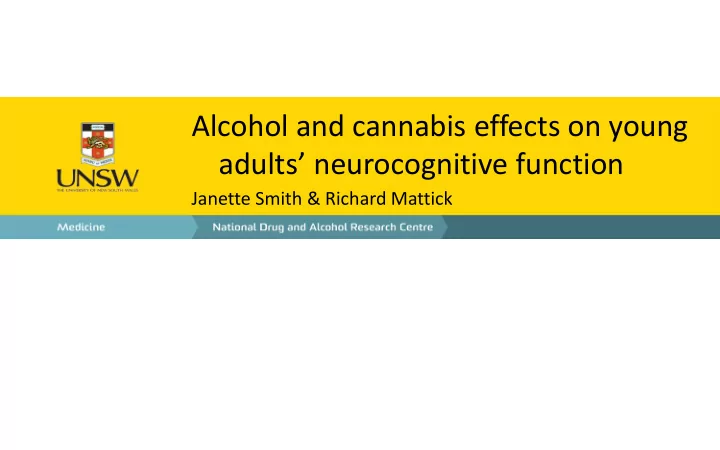

Alcohol and cannabis effects on young adults’ neurocognitive function Janette Smith & Richard Mattick
Introduction Adolescence and young adulthood is a period of maturation, with the frontal and • temporal lobes of the brain reaching maturity in the mid-twenties Executive function (e.g., decision-making, behavioural control, attentional control) • and memory processes are subserved by these regions, and are known to be damaged in older, substance-dependent individuals Are there subtle deficits in brain function in younger individuals who have been • using for a shorter period of time, but may be doing more damage to these developing areas of brain?
Methods Recruited 33/60 young adults aged 18-21 • Today, only presenting data from 25 participants who vary in • alcohol use and do not regularly use other drugs Examination of • Alcohol Use Disorders Identification Test (AUDIT) • Lifetime alcohol and cannabis use • The electrical activity of the brain is recorded • Tests of cognition; today, discussing only inhibitory control task • (the “stop-signal task”)
The stop-signal reaction time An estimate of the time • 300 needed to stop a response 250 SSRT (ms) Shorter SSRT reflects better • inhibitory performance 200 A higher AUDIT score is 150 • associated with a longer SSRT R² = 0.2911 100 (r = .540, p = .005), indicating deficient inhibition in 0 5 10 15 20 hazardous/harmful drinkers. AUDIT score
The error-related negativity A brain potential indexing • 0 monitoring of actions and ERN amplitude (µV) R² = 0.1631 detection of errors -5 Greater negativity relates to -10 • better performance -15 monitoring -20 Hazardous drinking is • associated with a smaller ERN 0 5 10 (r = .404, p = .045), indicating Hazardous AUDIT score deficient monitoring of performance in hazardous drinkers
Post-stop slowing After a signal to inhibit is • 150 presented, participants Post-stop slowing (ms) R² = 0.2093 100 typically slow down on the next trial 50 Greater post-stop slowing 0 • indexes greater trial-by-trial -50 adaptive adjustment of -100 performance 1 10 100 1000 10000 Those with a heavier lifetime • Lifetime standard drinks (10g alcohol) history of alcohol use show less adaptive adjustment (r = -.457, p = .021).
Hazardous/harmful drinkers show: Poorer behavioural inhibition – more likely to make impulsive, inappropriate • responses Poorer brain monitoring of performance – engage in less checking of actions • relative to desired outcomes for long-term goals Less adaptation of performance following inhibitory tests • If these results hold when the full sample is collected, atypicalities in inhibitory • processing are apparent in a younger group with less alcohol exposure than previously considered Correlation is not causation: It may be that these deficits precede and contribute • to later alcohol abuse problems – ask me next year!
Alcohol and cannabis effects on young adults’ neurocognitive function Janette Smith & Richard Mattick
Recommend
More recommend